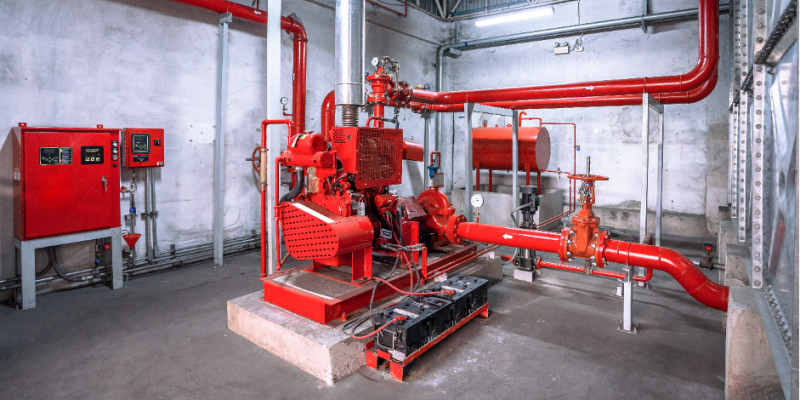
When a fire occurs, a fire pump is used to push or suck water from the reservoir. The pushed or sucked water is then distributed through pipes to meet the needs of hydrant and sprinkler systems.
Three types of fire pumps
In providing water for hydrant and sprinkler systems, a building needs at least three types of pumps: jockey, electric, and diesel. These pumps have interrelated functions. Check out the explanation below:
- Jockey Pump. The jockey pump serves to maintain the stability of water pressure in the hydrant and sprinkler system. It ensures the water pressure emitted by the hydrant and sprinkler is adequate and stable during the extinguishing process.
- Electric Pump. An electric pump is the main water supply pump for a water-based fire protection system in a building. The pump starts pushing the water after getting a signal from the jockey pump that the system has an insufficient water supply. The signal is transmitted through a pressure switch. The water will be pushed from the reservoir using a turbine. The turbine operates by relying on electrical power.
- Diesel Pump. The diesel pump's primary function is to support the electric pump in providing sufficient water during the extinguishing process. In addition, the diesel pump does not require electricity to operate. Thus, it can also be used as a backup pump if the electricity fails and causes the main pump or electric pump to die.
Fire pump capacity
Fire pump capacity is usually calculated in Gallons per Minute (GPM). There are several factors to consider when determining the capacity of a fire pump. Such factors are:
Fire pump placement
Based on NFPA 20 and the International Building Standard (IBC), several considerations are needed for the placement and installation of a building’s fire pump. First, the fire pump shall be placed inside a room separated from all other areas (of the building) by a two-hours fire barrier or horizontal assembly following the provisions of the IBC. For buildings less than 23 meters high, the fire barrier can be reduced to one hour if the entire building is equipped with an automatic sprinkler system. Second, the fire pump room must be easily accessible. In addition, this room should not be used to keep other equipment or objects that may distract the operation of the fire pump. Third, if the fire pump room cannot be accessed from the outside, it is recommended to access this room through a fireproof corridor from enclosed stairs or exterior exits.
Fire pump maintenance
Fire pump maintenance is essential to ensure their readiness to provide water during the extinguishing process. There are three actions to do for fire pump maintenance, which are:
- Prevent the component of the fire pump from locking by lubricating and moving them around.
- Check the fire pump components (e.g., the pressure relief valve, packing, and casing relief valve). In addition, make sure that everything is properly open and closed.
- Check the pressure gauge of the fire pump. If the pressure exceeds or is less than the set value, contact a professional from the fire protection field for advice.
Writer: Fitri Endrasari - Fire Engineer Ignis Fire & Risk
0 Comments